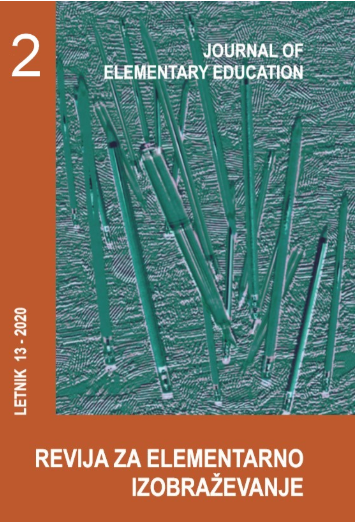The cognitive aspect of interactive learning and teaching in visual arts education
DOI:
https://doi.org/10.18690/rei.13.2.131-152.2020Keywords:
interactive approach to learning and teaching, visual arts, cognitive abilities, creative thinking,, critical thinkingAbstract
The task of contemporary visual arts education is to enable quality interaction among all subjects of the teaching process, through which the students are encouraged to think, imagine, and develop higherorder
cognitive activities. The objective of this empirical research study was to verify the differences in the results of students in the control and experimental groups (n=285) regarding their knowledge and understanding
of visual arts content. Analysis of the results shows that the students in EG showed significantly better results compared to the students in CG, which means that the interactive model of learning and teaching positively
influenced the students’ understanding of visual arts content.
Downloads
References
Alter, F. (2009). Understanding the role of critical and creative thinking in Australian primary school visual arts education. International Art in Early Childhood Research Journal, 1(1), 1–12.
Alter, F., Hayes, T., & O’Hara, R. (2009). Creative arts teaching and practice: Critical reflections of primary school teachers in Australia. International Journal of Education &the Arts, 10(9), 1–22.
Arov, H., & Jȍg, A. L. (2017). Supporting learning skills in visual art classes: The benefits of teacher awareness. Journal of Elementary Education, 10, (2–3). 145–162. DOI: 10.18690/1855-4431.10.2-3.145-162(2017)
Bakračevič Vukman, K. (2004). Točnost metakognitivnih ocen v različnih razvojnih obdobjih. Anthropos, 1(36), 377–384.
Butina, M. (1997). Uvod v likovno oblikovanje: priročnik za likovne šole. Ljubljana: Debora.
Caiman, C., & Jakobson, B. (2019). The Role of Art Practice in Elementary School Science. Science & Education, 28(1–2), 153–175.
Chishti, R., & Jehangir, F. (2014). Positive effects of elementary visual art on problem solving ability in later years of life. FWU Journal of Social Sciences, 8(1), 83–88.
Danesi, M. (2020). Mathematical Cognition and the Arts. Journal of Humanistic Mathematics, 10(1), 317–336. DOI: 10.5642/jhummath.202001.14
Duh, M., & Herzog, J. (2016). Monitoring the Level of Art Appreciation of Fourth-Grade Primary School Students. Croatian Journal of Education, 18(Sp. 2), 3–50.
Duh, M. (2016). Developing Art Appreciation in Students of Education from Different European Countries. The New Educational Review, 45(3), 112–123.
Efland, A. D. (2002). Art and Cognition: Integrating the Visual Arts in the Curriculum. New York/Reston: Teachers College Press, Columbia University and National Art Education Association.
Eisner, E. W. (1982). Cognition and curriculum: A basis for deciding what to teach. New York: Longman.
Eisner, E. W. (2002). Arts and the Creation of Mind. New Haven, London: Yale University Press.
Esola, L., & Nelson, K. (2019). Modernism of Art Education Theory. Transdisciplinary Inquiry, Practice, and Possibilities in Art Education, Proceedings from The Penn State Seminar @50. University Park, PA: The Pennsylvania State University Libraries Open Publishing. DOI: 10.26209/arted50-08
Fomichov, V. A., & Fomichova, O. S. (2019). The Student-Self Oriented Learning Model as an Effective Paradigm for Education in Knowledge Society. Informatica, 43(1). https://doi.org/10.31449/inf.v43i1.2356
Gardner, H. (1993). Multiple Intelligences: The Theory in Practice. New York: Basic Books.
Garvis, S. (2009). Improving the Teaching of the Arts: Pre-Service Teacher Self-Efficacy towards Arts Education. Online Submission, 6(12), 23–28.
Garvis, S., & Pendergast, D. (2012). Storying music and the arts education: The generalist teacher voice. British Journal of Music Education, 29(1), 107–123.
Ghanbari, S. (2015). Learning across disciplines: A collective case study of two university programs that integrate the arts with STEM. International Journal of Education & the Arts, 16(7).
Guilford, J. P. (1968). Intelligence, creativity, and their educational implications. San Diego, CA: Robert R. Knapp.
Hardiman, M. M. (2019). The Arts, Creativity, and Learning: From Research to Practice. In J.L. Contreras- Vidal, D. Robleto, J.G. Cruz-Garza, J.M. Azorín, & C. Nam (Eds.) Mobile Brain-Body Imaging and the Neuroscience of Art, Innovation and Creativity (pp. 199–206). Springer, Cham.
Karlavaris, B., & Berce-Golob, H. (1991). Likovna vzgoja: priročnik za učitelje razrednega pouka. Ljubljana: DSZ.
Keinänen, M., Hetland, L., & Winner, E. (2000). Teaching cognitive skill through dance: Evidence for near but not far transfer. Journal of Aesthetic Education, 34(3/4), 295–306.
Lin, C.-S., & Wu, R. Y.-W. (2016). Effects of web-based creative thinking teaching on students’ creativity and learning outcome. Eurasia Journal of Mathematics, Science & Technology Education, 12(6), 1675-1684. doi:10.12973/eurasia.2016.1558a
Mezirow, J. (Ed.). (2000). Learning as Transformation: Critical Perspectives on a Theory in Progress. San Francisco: Jossey-Bass.
Morris, J. E., Lummis, G. W., & Lock, G. (2017). Questioning art: Factors affecting students' cognitive engagement in responding. Issues in Educational Research, 27(3), 493–511.
Muhovič, J. (1992). Likovno mišljenje in likovna pojmovnost. Anthropos, 1992/1–2, 32–51.
Nilson, C., Fetherston, C. M., McMurray, A., & Fetherston, T. (2013). Creative arts: an essential element in the teacher's toolkit when developing critical thinking in children. Australian Journal of Teacher Education (Online), 38(7), 1.
Paek, K. M. (2019). The transformative potential of creative art practices in the context of interdisciplinary research. Creativity Studies, 12(1), 183–197.
Plut Pregelj, L. (2004). Konstruktivitične teorije znanja in šolska reforma: učitelj v vlogi učenca. In B. Marentič Požarnik (Ed.), Konstruktivizem v šoli in izobraževanje učiteljev, konferenčni zbornik (pp. 17–40). Ljubljana: Center za pedagoško izobraževanje Filozofske fakultete.
Russell-Bowie, D. E. (2012). Developing Preservice Primary Teachers' Confidence and Competence in Arts Education Using Principles of Authentic Learning. Australian Journal of Teacher Education, 37(1), pp. 60–74.
Senge, P. et al. (2000). Schools That Learn. London, Nicholas Brealey Publishing.
Siburian, J., Corebima, A. D., & Saptasari, M. (2019). The Correlation Between Critical and Creative Thinking Skills on Cognitive Learning Results. Eurasian Journal of Educational Research, 19(81), 99–114.
Downloads
Published
Issue
Section
License
Copyright (c) 2020 Jerneja Herzog

This work is licensed under a Creative Commons Attribution 4.0 International License.
